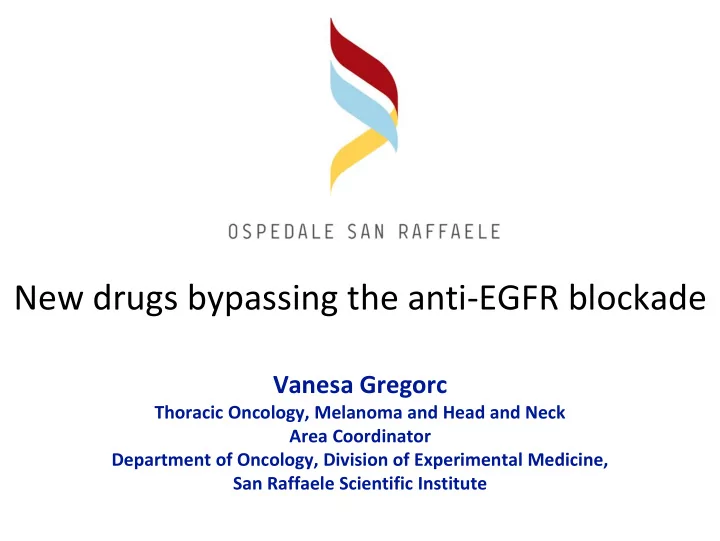

New drugs bypassing the anti-EGFR blockade Vanesa Gregorc Thoracic Oncology, Melanoma and Head and Neck Area Coordinator Department of Oncology, Division of Experimental Medicine, San Raffaele Scientific Institute
Heterogeneous acquired resistance mechanisms to EGFR-TKIs Camidge et al, Nat Rev Clin Oncol 2014
Treatment strategies for patients developing EGFR T790M mutation Osimertinib Rociletinib Olmutinib
Osimertinib is a recommended targeted therapy for EGFR T790M+ NSCLC - Phase II AURA2 trial RR 70% (95% CI 64-77) 210 EGFR mutated NSCLC carrying T790M Goss et al, Lancet Oncol 2016
Osimertinib and brain metastases 30% of EGFR mutant patients develop brain lesions in the course of EGFR-TKis Osimertinib and its metabolites AZ5104 and AZ7550 are substrates of Pgp and BCRP Ballard et al, Clinical Cancer Research 2016
Strategies under investigation to overcome brain progression - BLOOM - Phase I 21 patients receiving osimertinib Yang et al, ASCO 2016
AZD3759 - synthesized to overcome blood brain barrier replacement of the methylene group with nitrogen to improve stability permeability, solubility, efflux ratio incorporation of a methyl group to increase PK Zeng et al, Journal of Medicinal Chemistry 2016
How to identify the emerging mechanisms of acquired resistance - Analysis of circulating tumor DNA Retrospective analysis of EGFR mutant patients enrolled in the AURA trial High specificity (~100%), good sensitivity (>80%) for EGFR sensitizing mutations Good sensitivity and specificity for T790M (~70%) false negative results for EGFR sensitizing mutations false negative results for T790M Oxnard et al, JCO 2016
Response rate in T790M+ : tumor = plasma false negative results for T790M Oxnard et al, JCO 2016
Tumor Plasma T790M- Plasma T790M+ Plasma Tumor positive, plasma negative ( 16.5 months ) > Tumor positive, plasma positive ( 9.3 months )> Tumor negative, plasma positive ( 4.2 months ) Oxnard et al, JCO 2016
How to identify the emerging mechanisms of acquired resistance - Analysis of circulating tumor DNA - Integrates contribution from many tumor deposits - More accurate identification of the heterogeneous resistance mechanisms SCNA: somatic copy number alterations SNV: single nucleotide variants Chabon et al, Nature communications 2016
How to define the emerging mechanisms of acquired resistance - Which methods? 38 patients enrolled in the AURA trial 72 patients enrolled in the AURA trial Digital platforms are more sensitive and quantitative , allowing quantification of longitudinal plasma samples BUT CONSIDER biological FALSE POSITIVE Thress et al, Lung Cancer 2015
A proposed paradigm for use of plasma genotyping Conventional paradigm If A not possible Alternate paradigm Oxnard GR, JCO 2016
Plasma T790M+, Tumor T790M+ Plasma T790M+, Tumor T790M- Heterogeneity and T790M is a minor clone pl T790M-/sens+ pl T790M-/sens- ORR (%) 38 (26 - 50) 64 (45 - 79) Lack of tumor DNA PFS (m) 4.4 (2.8 - 6.8) 15.2 (11.0 - 17.9) Oxnard et al, JCO 2016
Longitudinal monitoring of EGFR sensitizing and T790M mutations OPEN QUESTION - How many patients develop EGFR T790M earlier than RECIST progression - What is timing of EGFR T790M development and the clinical significance of early EGFR T790M detection?
Longitudinal monitoring of EGFR sensitizing and T790M mutations 35 (46%) patients developed EGFR T790M, 16 (45%) of whom earlier than clinical progression (median time 2.2 months, increasing progressively from 6 months prior PD to 4 months beyond PD) Zheng et al, Scientific Reports 2015
Acquired resistance mechanisms to third generation EGFR- TKIs - C797S C797S in exon 20 (abrogates the irreversible binding of third generation) 40% of cases opposite to T790M in the ATP binding pocket Ortiz-Charan et al; Clin Canc Res 2015. Thress et al; Nature Medicine 2015. Yu HA et al; JAMA 2015
Acquired resistance mechanisms to third generation EGFR- TKIs - C797S TRANS CIS C797S coexists with T790M on the same alleles C797S and T790M are on different alleles Resistance to all 3 generations EGFR-TKIs Sensitive to 1st/2nd generations EGFR-TKIs Third generation require cyst for binding First and second generation do not bind cyst Niederst et al; Clin Canc Res 2015
Niederst et al; Clin Canc Res 2015
Acquired resistance mechanisms to third generation EGFR- TKIs - MET and ERBB2 At baseline At progression ERBB2 and MET amplification decrease sensitivity to third generation EGFR-TKIs Ongoing studies: - savolitinib + osimertinib (TATTON trial) Ortiz-Charan et al; Clin Canc Res 2015
Acquired resistance mechanisms to third generation EGFR- TKIs - KRAS KRAS G12S in tissue T790M - in tissue C797S + in blood S= selumetinib T= trametinib Ortiz-Charan et al; Clin Canc Res 2015. Thress et al; Nature Medicine 2015
Acquired resistance mechanisms to third generation EGFR- TKIs - KRAS Ongoing studies: - selumetinib + osimertinib (TATTON trial) Eberlein et al; Canc Res 2015. Tricker et al; Cancer Discovery 2015
OSIMERTINIB + DURVALUMAB (Tatton trial) Part A Part B - EGFR mutated pre treated - EGFR mutated naive NSCLC NSCLC patients patients - No controindicazioni to - No controindicazioni to immunotherapy immunotherapy - No history of ILD - No history of ILD Dose escalation Dose expansion Increased percentage of ILD 23 patients in PART A (12 PR, 9 SD) 11 patients in PART B (8 PR, 2 SD) Ahn et al; ELCC 2016
Treatment strategies for patients developing MET alterations Type I MET inhibitors Type II MET inhibitors Bind the active conformation of MET Bind the inactive conformation of MET (crizotinib) (cabozantinib) (savolitinib) Resistance driven by ERBB3 dependent PI3K pathway activation Drilon et al; JTO 2016
MET alteration One challenge is defining the appropriate method and positivity cut point for identifying MET gene copy-number gain In a phase II study, EGFR-mutant patients with acquired resistance to an EGFR TKI were treated with the combination of gefitinib and capmatinib (response rate 40% among those with a MET copy- number ≥ 5)
Bivona et al. Nature Med 2016
Recommend
More recommend